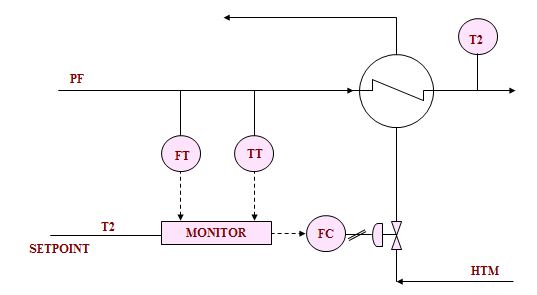Distillation Control
- Component segregation is achieved by control of heat input
- Stream splitting is achieved by control of product flow
- Column pressure is dictated by many factors as, condensing media temperature, heat sensitivity of the material, heating media temperature, relative volatility and so on.
- Column pressure too high – feed system may be unable to input feed to the column. Allowable design pressure may exceed.
- Column pressure too low – Product may not flow from system
- Too high bottom temperature – Product degradation.
- Rapid Variation in Flow or pressure -Control of u/s equipment becomes impossible.
Feedback control of pf outlet temperature
Flow rate of HTM is adjusted as PF outlet temperature is perturbed.
Valve may be shown in either supply or return line.
Feed - forward control of PF outlet temperature
PF outlet setpoint T2 and perturbations of PF input flow and
Temperature are fed to monitor which adjusts flow rate of HTM to
Maintain constant PF outlet temperature T2
To get constant top vapor product composition, condenser outlet temperature needs to be controlled
Temperature control
Measure of composition.
Temperature is controlled either at top or bottom depending on which product specification is important.
For high purity operation temp. will be controlled at intermediate pt.
The pt. Where dT/dC is max. is the best place to control temp.
Column top temp
Controlled by manipulating reflux.
For partial condenser it is typical to control condenser outlet temperature instead of column top temp
Condenser on temperature control of PF condensate
However, throttling of HTM flow could make it too hot at the outlet condenser
Condenser on pressure control of HTM flow
However, throttling of HTM flow makes it too hot at the outlet
Flow rate of condensate is controlled by PF vapour pressure
If column pressure rises, condensate flow rate increases
Condenser with vapor bypass to reflux drum
Condenser and drum partially filled with sub-cooled condensate
When pressure falls, vapor flows directly to drum and heats liquid
Resulting increase in vapor pressure forces some of the liquid back into the Condenser so that the rate of condensation decreases and consequently the pressure is restored to the preset value
With sufficient sub-cooling a difference of 10-15 ft. in levels of drum and condenser is sufficient for good control by this method
Air flow rate is controllable with adjustable louvers, variable pitch fan Or variable-speed motors
Last two methods achieve some power saving compared to louver design Multi speed motors used for change between day and night and between Winter and summer Automatic switching based on air temperature
Feed Temperature : This is critical as this decides the vapor & liquid flow in feed zone. Often amount of heat available in the bottom is close to the optimum feed preheat.
Flow of steam controlled off the PF outlet temperature, and condensate is removed with steam trap or under liquid level control.
Temperature control on condensate removal has the effect of varying amount of flooding of heat-transfer surface and hence, the rate of condensation, because the flow of condensate through the valve is relatively slow.
Level in condensate pot can be varied to change effective area of heat transfer
Results in smoother operation
Flashing of condensate across level control valve avoided
Higher heat transfer area require
Steam pressure responds quickly to upsets in steam supply conditions
More sluggish PF temperature at outlet is used to adjust pressure to maintain proper heat transfer
FIG. -Feed preheating
Details : Feed flow control cascaded with level in feed sure drum
Temperature of feed to column controlled by manipulating steam flow to heat exchanger
Features : Feed temperature desired - 100°c
Condensate pot used to control level in feed-steam heater
Application : Light reformate feed to DIH in FCCU (0.62% BZ in gasoline project)
Column Bottom Temperature
Reboiler outlet temp. indicator is used for controlling.
For smooth control cascade arrangement with FRC on heating media flow. The set point of which is manipulated by TRC at the reboiler outlet.
Vaporizer with HTM , flow rate controlled by temperature of PF vapor HTM may be liquid or vapor.
A constant rate of heat input is achieved by flow control of HTM or steam
HTM may be either liquid or vapor.
Flow control on HTM supply responds rapidly to changes in heat supply System
More sluggish TC on PF vapour resets FC if needed to maintain PF vapour temperature
Details : 1. Steam on flow control 2. Column bottom on level control
Features : Compared to kettle-type reboiler overall heat transfer coefficient is higher
Surface fouling is low
Shorter residence time prevents overheating of thermally sensitive materials
Positioning of thermo syphon reboiler relative to the column bottom at proper elevation is critical
Application: N-hexane Recovery column
Cascade Control on Reboiler Steam Flow Rate
Details : Temp. control at a particular tray achieved by a temp. controller which resets flow controller on steam (HTM) line
Column bottom level controlled by adjusting bottoms flow rate
Features : Flow measurement of steam may not be accurate
Flow element requires frequent calibration
DETAIL
Column bottom temperature controlled by temperature control on HTM
Level controlled by level controller on bottoms (product) line
Liquid inlet to reboiler is on flow control minimum flow bypass required but not shown
FEATURES
High rate of heat transfer and short residence time which are desirable for thermally sensitive materials, are achieved
Better control of flow to reboiler
APPLICATION
n-Hexane recovery column
Details
Temperature control at column bottom achieved with help of a control valve on hot-oil supply to reboiler.
Column level control achieved by adjusting bottoms flow rate.
Features
Differential pressure controller between supply and return of hot oil avoids build-up of excessive pressure if its flow to the reboiler is throttled substantially.
DPC control system ensures constant flow in hot oil circuit.
up to 74



















